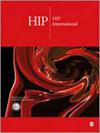全髋关节置换术中的脊柱骨相互作用:对 295 名患者进行至少 10 年的随访
IF 1.1
4区 医学
Q3 ORTHOPEDICS
引用次数: 0
摘要
背景:接受全髋关节置换术(THA)的患者经常会并发脊柱病变。在这项研究中,我们研究了脊柱骨盆相互作用是否会影响至少随访10年的全髋关节置换术的结果。患者和方法:我们对2006年至2009年间接受全髋关节置换术的295名患者进行了评估,这些患者的平均年龄为63.3岁(56-80岁之间)。其中,195 名患者患有轻度腰椎间盘退变,100 名患者患有晚期腰椎病。我们分析了哈里斯髋关节评分(HHS)的变化以及术后腰背痛(LBP)和脱位的存活率。结果:女性患者(p = 0.009)、65 岁患者(p <0.001)和晚期腰椎病患者(p = 0.002)的 HHS 平均值较低。52名(71.2%)术前报告有腰痛的患者在 THA 术后症状有所改善,而 47 名(21.1%)术前无腰痛的患者在术后报告有新发腰痛。女性患者(P = 0.025;危险比 [HR]:1.831;95% CI,1.081-3.101)和术前有腰背痛的患者(P = 0.007;HR 2.068;95% CI,1.221-3.504)在 10 年后发生术后腰背痛的风险更高。在9例THA脱位中,有4例脱位时间较晚,随着时间的推移,SFP角度值不断减小。髋臼组件倾斜角和前内翻角随着时间的推移而增加,而SFP角度与性别和年龄有关,PO角度与年龄和术前腰椎退变的严重程度有关。性别、年龄和相关的腰椎退行性病变会随着时间的推移影响临床和放射学变化。晚期脱位患者的SFP角度值会随着时间的推移而减小。本文章由计算机程序翻译,如有差异,请以英文原文为准。
Spinopelvic interactions in total hip arthroplasty: 295 patients followed for a minimum follow-up of 10 years
Background:Concurrent spinal pathology is frequent in patients undergoing total hip arthroplasty (THA). In this study we examined whether spinopelvic interactions affect THA outcomes at a minimum follow-up of 10 years.Patients and methods:295 patients with a mean age of 63.3 (range 56‒80) years receiving a THA between 2006 and 2009 were assessed. Of these, 195 had mild lumbar disc degeneration and 100 had advanced lumbar spondylosis. We analysed the changes in the Harris Hip Score (HHS) and the survival rate for postoperative low back pain (LBP) and dislocation. Changes in acetabular component position, sacro-femoral-pubic (SFP) and pelvic obliquity (PO) angles were assessed with radiological images.Results:The mean HHS was lower in female patients ( p = 0.009), patients >65 years of age ( p < 0.001) and those with advanced lumbar spondylosis ( p = 0.002). 52 (71.2%) of the patients reporting preoperative LBP experienced improvement after THA while 47 (21.1%) of those without preoperative LBP postoperatively reported new onset LBP. Female patients ( p = 0.025; hazard ratio [HR]: 1.831; 95% CI, 1.081–3.101) and those with preoperative LBP ( p = 0.007; HR 2.068; 95% CI, 1.221–3.504) were at a higher risk of developing postoperative LBP at 10 years. 4 out of 9 THA dislocations were late and had shown decreasing SFP angle values over time. Acetabular component inclination and anteversion angles increased over time, whereas the SFP angle was associated with sex and age and the PO angle with age and the severity of any preoperative lumbar degeneration.Conclusions:Concurrent spinal pathology influences THA outcomes at a minimum follow-up of 10 years. Sex, age, and associated lumbar degeneration can affect clinical and radiological changes over time. A decrease in SFP angle values over time was found in patients sustaining late dislocation.
求助全文
通过发布文献求助,成功后即可免费获取论文全文。
去求助
来源期刊

HIP International
医学-整形外科
CiteScore
4.20
自引率
0.00%
发文量
70
审稿时长
2 months
期刊介绍:
HIP International is the official journal of the European Hip Society. It is the only international, peer-reviewed, bi-monthly journal dedicated to diseases of the hip. HIP International considers contributions relating to hip surgery, traumatology of the hip, prosthetic surgery, biomechanics, and basic sciences relating to the hip. HIP International invites reviews from leading specialists with the aim of informing its readers of current evidence-based best practice.
The journal also publishes supplements containing proceedings of symposia, special meetings or articles of special educational merit.
HIP International is divided into six independent sections led by editors of the highest scientific merit. These sections are:
• Biomaterials
• Biomechanics
• Conservative Hip Surgery
• Paediatrics
• Primary and Revision Hip Arthroplasty
• Traumatology
 求助内容:
求助内容: 应助结果提醒方式:
应助结果提醒方式:


